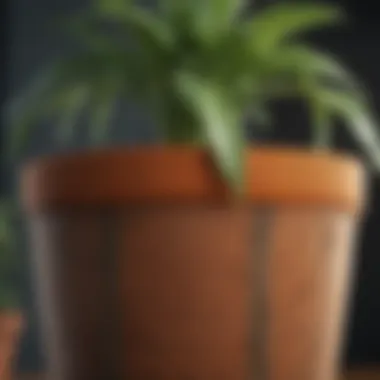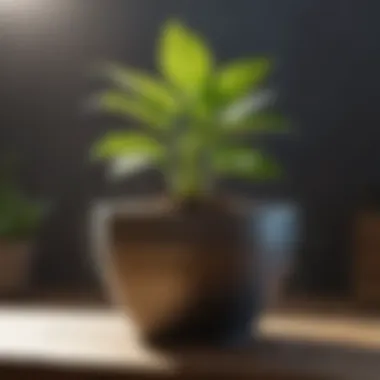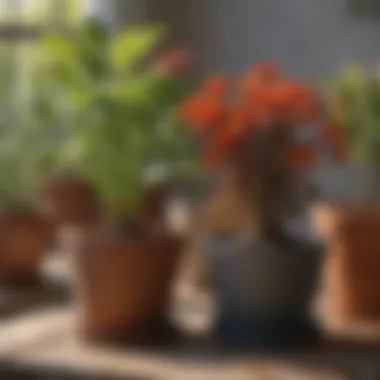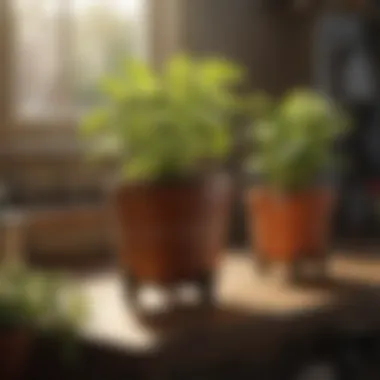Exploring Self-Watering Fabric Pots for Optimal Gardening


Intro
In the realm of modern horticulture, the emergence of self-watering fabric pots has transformed the way we approach container gardening. These innovative tools offer a unique solution to one of the primary challenges in gardening: maintaining optimal soil moisture levels. This article will delve into the essential aspects of self-watering fabric pots, highlighting their construction, functionality, benefits, drawbacks, and practical applications.
Understanding how these pots work is crucial for both novice gardeners and experienced horticulturists. By mastering the science behind soil moisture management, one can optimize plant health and enhance yields. Through this analysis, we will explore key techniques and innovations that relate to self-watering fabric pots, as well as practical applications and real-world examples that showcase their effectiveness in various gardening environments.
In this exploration, our aim is to provide a thorough understanding of self-watering fabric pots and how they fit into sustainable gardening practices. Let's start by examining the topic in greater detail.
Prolusion to Self-Watering Fabric Pots
Understanding self-watering fabric pots is essential for gardeners aiming to optimize plant health and growth. These innovative containers present a modern solution to traditional gardening challenges, especially in water management. The ability to maintain consistent moisture levels can significantly influence plant development. Therefore, having a well-rounded insight into their characteristics, advantages, and implementation strategies is valuable for both novice and experienced horticulturists.
Definition and Concept
Self-watering fabric pots are designed with a multi-layered system that enables plants to access water as needed. They comprise breathable materials that allow air circulation while preventing root rot. The concept revolves around maintaining an optimal moisture balance, achieved through a water reservoir situated at the bottom of the pot. As the soil loses moisture, it draws water from the reservoir via capillary action. This design not only promotes healthier roots but also reduces the frequency of watering. Their capacity to regulate moisture creates an ideal environment for many plant species, making them a popular choice among gardeners.
Historical Development
The concept of self-watering pots is not entirely new. Historical records suggest that similar gardening techniques were used as far back as ancient civilizations, involving various forms of irrigation systems. However, the modern self-watering pot gained popularity in the late 20th century with advancements in materials and gardening technology. Initially crafted from plastic, these pots gradually evolved to incorporate fabric, which enhanced breathability and water retention. Today, self-watering fabric pots embrace innovation, integrating various designs to cater to diverse gardening needs. Understanding this evolution can help gardeners appreciate the benefits generated by these versatile pots.
Advantages of Self-Watering Fabric Pots
Self-watering fabric pots offer several benefits that enhance their appeal, particularly for avid gardeners and agricultural enthusiasts. Understanding these advantages is essential for optimizing plant health, minimizing labor, and contributing to efficient water usage. These pots combine technology with natural processes, fostering a conducive environment for plant growth.
Improved Soil Health
The structure of self-watering fabric pots promotes superior soil health compared to traditional planting methods. The fabric allows for air circulation, which is crucial for healthy root development. In these pots, roots can grow freely without becoming root-bound, thus enhancing nutrient uptake.
Moreover, moisture is consistently regulated. Excess water drains away, lessening the risk of water saturation, which can lead to root rot. This balance in moisture retention supports beneficial microorganisms in the soil, aiding in decomposition and nutrient cycling.
Also notable is the lower salt concentration in the soil. With reduced runoff from over-watering, harmful salts accumulate less. This preservation is vital for maintaining healthy soil ecology and ensures a nutritious environment for plants to thrive.
Reduced Watering Frequency
One of the most practical benefits of using self-watering fabric pots is the significant reduction in the frequency of watering. The reservoir in the bottom of the pot continually supplies moisture to the soil through capillary action. This setup minimizes the daily or weekly commitment of time typically spent on irrigation.
During warmer seasons or dry spells, the water reservoir allows plants to draw moisture as needed without constant human intervention. This leads to more consistent watering, preventing drought stress that could hinder plant growth. Additionally, this efficiency leads to conservation of water resources, a vital consideration in regions facing drought conditions.
Enhanced Plant Growth
Plants in self-watering fabric pots benefit from a stable supply of moisture and nutritious soil environment, which can lead to enhanced growth rates. With regulated moisture levels, plants do not undergo shock from sudden changes in water availability. This stability is particularly important during critical growth phases.
The breathable nature of the fabric ensures excellent drainage and aeration, both essential factors contributing to vigorous root growth. Enhanced root development ultimately supports larger, healthier plants. Plants are often more resilient against diseases as they enjoy balanced nutrition and moisture.
In addition, because these containers maintain an optimal growing environment, gardeners can experiment with diverse plant species, moving beyond traditional options and including those that thrive in varied moisture levels.
Components of Self-Watering Fabric Pots
Understanding the components of self-watering fabric pots is crucial for anyone looking to optimize their gardening experience. These components significantly influence how effective the pots are in maintaining soil moisture and promoting healthy plant growth. This section will break down the key elements, their benefits, and considerations that are associated with self-watering fabric pots.
Material Properties
Breathability
Breathability is a fundamental characteristic of self-watering fabric pots. This feature allows air to circulate freely around the roots of the plants. It helps to prevent root rot, a common issue in traditional pots with less aeration. The textile used in these pots is designed with tiny pores that provide adequate oxygen exchange.
A breathable pot promotes healthier root development and reduces the risk of diseases that thrive in stagnant humidity. The ability of these pots to allow moisture to escape without drying out the soil too rapidly is also a key advantage. However, if the fabric is too porous, it may not hold moisture as effectively, which can lead to under-watering.


Durability
Durability is another essential aspect of self-watering fabric pots. High-quality materials are used to ensure that the pots can withstand environmental stressors such as UV rays, moisture, and temperature fluctuations. A durable pot lasts longer, reducing the need for frequent replacement, which can be cost-effective over time.
The robustness of the materials also allows these pots to handle the weight of soil and plants without tearing or breaking. Nonetheless, it is important to balance durability with flexibility, as overly rigid materials may not offer the benefits of traditional fabric pots, such as easy storage.
Weight Considerations
Weight considerations are significant when selecting self-watering fabric pots, particularly for urban gardening or installations on balconies. The choice of materials affects how light or heavy these pots will be when filled with soil and plants. Lightweight materials are easier to move and manage.
However, if the pot is too light, it may not be stable enough to support taller plants or withstand wind, leading to potential tipping. Customizing the weight with soil selection can mitigate this issue, ensuring both ease of handling and stability.
Water Reservoirs
Design Variations
Design variations in water reservoirs are crucial for the overall performance of self-watering fabric pots. Different reservoirs can provide distinct advantages, such as varying water supply systems. Some pots may feature a bottom reservoir that allows for capillary action, while others might have side containers for water absorption.
These variations allow gardeners to choose a design that best suits their specific planting needs. The flexibility in design also allows users to develop tailored solutions for different plant types, ensuring optimal watering strategies.
Functionality
The functionality of the water reservoirs contributes significantly to the self-watering mechanism. A well-designed reservoir automatically regulates moisture levels in the soil through capillary action, which is coded into the pot's structure. This system reduces the frequency of watering and helps maintain consistent soil moisture, benefitting plants during drought conditions.
However, improper use of the reservoir, such as overfilling, can lead to issues like waterlogging, which is detrimental to plant health. Therefore, understanding how to manage these reservoirs effectively is essential for successful gardening.
Soil and Substrate Choices
Water Retention Capacity
Water retention capacity is a vital consideration for the type of soil or substrate used in self-watering fabric pots. Different soil mixtures hold varying amounts of moisture, which can impact plant growth. A substrate with high water retention can maintain adequate moisture levels for an extended period, reducing the frequency of watering further.
Choosing the right blend is critical for achieving a balance between moisture retention and drainage. For instance, adding materials like coconut coir can enhance water retention while maintaining good aeration.
Drainage Characteristics
Drainage characteristics also play a key role in the health of plants grown in self-watering fabric pots. A well-draining soil mix allows excess water to escape, while still holding enough moisture for the plants' needs. Without proper drainage, there is a risk of root rot or mold growth.
Using a combination of soil amendments can improve drainage while ensuring that the substrate retains enough water. Understanding the drainage needs of specific plants will aid in selecting the correct substrate composition for successful growth.
The efficiency of self-watering fabric pots largely depends on the harmony between their components, ensuring both functionality and plant health.
How Self-Watering Fabric Pots Work
Understanding how self-watering fabric pots function is crucial for anyone interested in improving their gardening practices. The benefits of these pots derive from their unique design that allows for efficient water and air management. This section will explain two primary mechanisms: wicking action and moisture regulation, both of which are essential for plant health.
Wicking Action
Wicking action is the driving force behind self-watering technology. It involves the movement of water from a reservoir to the soil through a material that permits moisture transfer. In self-watering fabric pots, a combination of fabric and substrate plays a significant role in this action.
The fabric is typically made from materials that are porous and breathable, which facilitates water movement. When the soil becomes dry, the moisture is drawn up from the reservoir through capillary action. This natural process helps maintain consistent soil moisture levels, crucial for optimal root development. Unlike traditional pots, where water can easily pool at the bottom, self-watering pots distribute moisture evenly across the soil. This prevents the risk of overwatering and encourages deeper root growth.
Moisture Regulation
Moisture regulation is another vital feature of self-watering fabric pots. The design allows the gardener to set a proper moisture baseline for plants. When the soil reaches its desired moisture level, the wicking stops, ensuring the roots do not become oversaturated.
This is especially beneficial for species that are sensitive to fluctuating moisture conditions. By providing a more stable environment, plants can become more resilient against stress factors, such as drought or excessive rainfall. Regular checks of the water reservoir can help maintain this balance without excessive effort.


"Self-watering pots offer a revolutionary approach, combining simplicity with scientific principles for successful gardening."
Summary
Best Practices for Using Self-Watering Fabric Pots
Using self-watering fabric pots effectively requires proper techniques and attention to details. Implementing best practices can enhance the benefits these pots provide. The goal is both efficient water management and maintaining healthy plant roots. There are several factors to consider, and understanding each component can lead to better results in container gardening.
Selection of Plants
Suitable Species
Choosing suitable species for self-watering fabric pots can greatly influence the success of your gardening venture. Some plants thrive in consistent moisture levels, making them a perfect fit for this type of container. For example, herbs like basil and mint enjoy moisture without becoming waterlogged. Their roots benefit from the aeration that fabric pots provide, which contributes to healthy growth.
A key characteristic of these plants is their adaptability. Many can flourish in the nutrient-rich environment that self-watering fabric pots promote. However, it is essential to avoid overly delicate plants that require strict watering schedules. The porous nature of fabric pots may not maintain the extreme control those plants need, leading to stress or even death.
Growth Habits
Understanding the growth habits of chosen plants is crucial. Some plants are more aggressive in their growth, while others remain compact. Plants like tomatoes require more room to spread out and develop a robust root system. On the other hand, smaller plants such as succulents can thrive in the confined space of self-watering fabric pots.
The significant feature of growth habits is their effect on moisture uptake. Fast-growing species may consume water quickly, necessitating more frequent checks of the reservoir. Conversely, slower-growing plants will rely on the storage to avoid drying out. Balancing plant selection with their growth characteristics ensures effective use of water resources.
Watering Techniques
Initial Watering
The initial watering is a critical step when setting up self-watering fabric pots. This process saturates the soil and reservoir, establishing the moisture level necessary for plant health. Start with a thorough watering until you see water escaping from the drainage holes. This not only charges the reservoir but also ensures proper wicking.
A common mistake is to rush this process. If the soil isn't adequately hydrated from the start, the plants may struggle later. Using a moisture meter can help determine if the soil is ready. Ensuring this step is performed correctly sets the foundation for successful growth.
Maintenance Schedule
Establishing a maintenance schedule for checking water levels is key for long-term success. This involves routine monitoring of the reservoir and adjusting as needed depending on environmental conditions. In warmer climates, frequent checks may be required as plants actively absorb water.
A structured maintenance schedule also helps prevent unforeseen issues such as algae growth or overwatering. Checking the reservoir every few days allows for timely interventions, supporting both plant health and pot longevity. Regular monitoring gives gardeners peace of mind and promotes optimal plant growth.
Soil Management
Soil Composition
Careful consideration of soil composition is vital when using self-watering fabric pots. A blend with good drainage properties, such as a mix of peat moss, perlite, and compost, aids in moisture retention without risking waterlogging. Balanced soil composition promotes healthy root development and efficient water uptake.
One beneficial aspect of such soil mixtures is their adaptability. You can customize the blend based on specific plants' needs. However, avoid heavy soils that can compact easily, as this may hinder drainage and airflow.
Regular Mixing
Regular mixing of the soil is another best practice to maintain optimal growing conditions. Mixing helps prevent compaction, ensuring the soil remains aerated and allows for proper water movement. This encourages healthy root growth and nutrient distribution.
Additionally, mixing the soil periodically helps to incorporate any fertilizers or amendments that may be added. It also allows for the removal of decaying organic matter, which could lead to pests or disease. A simple practice of stirring the top layer can significantly impact the overall health of the plants and their ability to thrive in self-watering fabric pots.
Tip: Always consider your specific plant needs when determining the best strategy for usage. This approach will lead to more productive gardening experiences.
Challenges and Limitations of Self-Watering Fabric Pots
Self-watering fabric pots represent a step forward in modern gardening practices, but they are not without their challenges. It is essential to recognize these limitations to fully optimize their use. Understanding the possible issues and associated costs helps gardeners make informed decisions. This section aims to highlight these concerns while maintaining a holistic view of self-watering fabric pots.
Potential Issues


Overwatering Risks
One significant aspect of using self-watering fabric pots is the potential for overwatering. Overwatering can lead to several problems, including poor root development and plant stress. This risk stems from the capacity of the reservoir to hold water, sometimes causing soil saturation. A key characteristic of this risk is the balance between too much and too little water. While the self-watering mechanism aims to keep plants hydrated, it can easily tip towards overwatering if the gardener does not monitor the moisture levels. This makes understanding the specific needs of each plant crucial to effective gardening with these pots. Furthermore, overwatered plants may exhibit signs like yellowing leaves or wilting, signaling distress. To mitigate these risks, gardeners should regularly check the soil moisture and adjust watering schedules accordingly.
Algae Growth
Another potential issue within the realm of self-watering fabric pots is algae growth. Algae thrive in moist environments and can undermine plant health by competing for nutrients. This growth can occur quickly, especially in stagnant water pools found in the reservoir. A critical characteristic of algae growth is its ability to cover the soil surface, inhibiting light exposure for the roots. While some gardeners may initially overlook this issue, it is important to recognize that the presence of algae can lead to more significant problems down the line. One unique feature of algae growth is its potential to create an ecosystem that may attract pests, further harming plants. To mitigate algae, regular cleaning of the reservoir and ensuring proper drainage can be beneficial practices.
Cost Considerations
Cost is a paramount consideration when investing in self-watering fabric pots. Initially, these pots might appear more expensive than traditional planters; however, their potential for long-term savings is important to weigh. The investment in quality materials can translate into improved durability and better plant outcomes, reducing spending on replacements or additional resources. Factors such as material selection, size, and design will impact the overall cost. While opting for premium pots might require a higher upfront investment, they typically offer enhanced functionality and effectiveness. Moreover, considering the sustainability aspect of these pots may justify the expense. Gardeners should evaluate their budget and gardening goals to find the right balance.
In summary, while self-watering fabric pots offer several advantages, it is important to address challenges such as overwatering risks, algae growth, and costs associated with their purchase.
Choosing the right plants, understanding water management, and opting for quality materials are crucial for success.
Environmental Impact of Self-Watering Fabric Pots
The topic of environmental impact concerning self-watering fabric pots is crucial in the context of sustainable gardening practices. These pots not only serve the practical purpose of supporting plant growth but also offer a reevaluation of how gardening can contribute positively to the environment. Furthermore, they encourage efficient use of water and materials, thereby promoting better ecological footprints.
Sustainability Aspects
Water Conservation
Water conservation is a significant aspect of self-watering fabric pots. These pots effectively utilize a wicking mechanism that draws moisture from a reservoir. This design minimizes excessive watering, ensuring that water is used efficiently. The key characteristic of this system is its ability to maintain optimal moisture levels, which is essential for plant health. Consequently, it becomes a beneficial choice for gardeners who wish to save water while promoting plant growth.
Additionally, by reducing the frequency of watering, gardeners lower their water consumption significantly. This unique feature provides advantages like lowered water bills and reduced environmental stress during dry seasons. Nevertheless, gardeners must be cautious of using overly water-retentive substrates, as they can lead to root rot if not managed properly.
Material Sourcing
Material sourcing contributes significantly to the environmental impact of self-watering pots. The fabrics used for these pots often derive from recycled or sustainable resources. This aspect is vital as it highlights a movement towards greener practices within the gardening industry. A key characteristic of sustainable material sourcing is its focus on reducing reliance on non-renewable resources, which is beneficial in creating an eco-friendlier product.
Moreover, self-watering pots can be produced with minimal carbon footprint if responsibly sourced. They can come in various forms, such as recycled plastics or woven natural fibers, each with distinct advantages and disadvantages. Some materials may offer higher durability while others contribute less to pollution. Gardeners should consider these factors when choosing pots, as it influences not only their gardening success but also their environmental responsibilities.
Comparative Analysis
Traditional Pots vs. Self-Watering Pots
The comparison between traditional pots and self-watering pots reveals significant insights regarding water management and plant health. Traditional pots often encourage a more manual approach of frequent watering, which can lead to either underwatering or overwatering. In contrast, self-watering pots provide a built-in irrigation system that balances moisture levels automatically, making them an advantageous choice for those looking to simplify their gardening routines.
A significant feature of self-watering pots is their ability to promote better root health by providing consistent moisture. This characteristic can greatly enhance plant growth and resilience, especially in fluctuating environmental conditions. On the other hand, traditional pots might be easier to find and less expensive initially. However, the long-term benefits of self-watering pots often outweigh these concerns, as they lead to healthier plants and potentially reduced costs in water management over time.
"Choosing the right pot can drastically affect not only the plant’s growth but also the gardener's water usage and impact on the environment."
End
The exploration of self-watering fabric pots reveals significant insights that affect both novice gardeners and experienced horticulturists. Their functionality enhances effective moisture management, contributing to better plant health and growth. These pots demonstrate how innovation in gardening tools can lead to practical solutions that address common gardening challenges such as inconsistent watering and soil health.
Summary of Key Insights
Self-watering fabric pots are designed to optimize plant care through effective water regulation. They incorporate features such as a built-in reservoir and wicking systems, which allow moisture to be drawn up into the soil as needed. Notably, the advantages of these pots include:
- Improved Water Efficiency: They minimize water use while maximizing availability to plants.
- Enhanced Soil Health: These pots promote aeration and prevent root rot, making them ideal for plant growth.
- Less Frequent Watering: With a self-watering mechanism, gardeners experience a reduction in the frequency of watering tasks.
Overall, those who adopt self-watering fabric pots may notice increased yields and reduced labor, affirming their value in modern container gardening.
Future of Container Gardening
The future of container gardening, through the lens of self-watering fabric pots, suggests a move toward more sustainable practices. As awareness of water conservation and sustainable gardening grows, these pots present a viable option for adapting to climate change and resource scarcity. Some considerations for the future of container gardening include:
- Increased Adoption of Sustainable Materials: As environmental awareness rises, the use of eco-friendly materials in manufacturing pots is likely to grow.
- Education on Efficient Gardening Practices: More resources will be available to educate gardeners about effective container gardening techniques.
- Integration with Smart Technology: Future planting solutions may involve smart systems for monitoring soil moisture and ensuring optimal conditions for growth.
In summary, self-watering fabric pots are not only a practical solution for the current horticultural landscape but also a gateway to innovative approaches that align with sustainable gardening practices. The ongoing development in this field indicates a promising future for both plants and gardeners alike.



